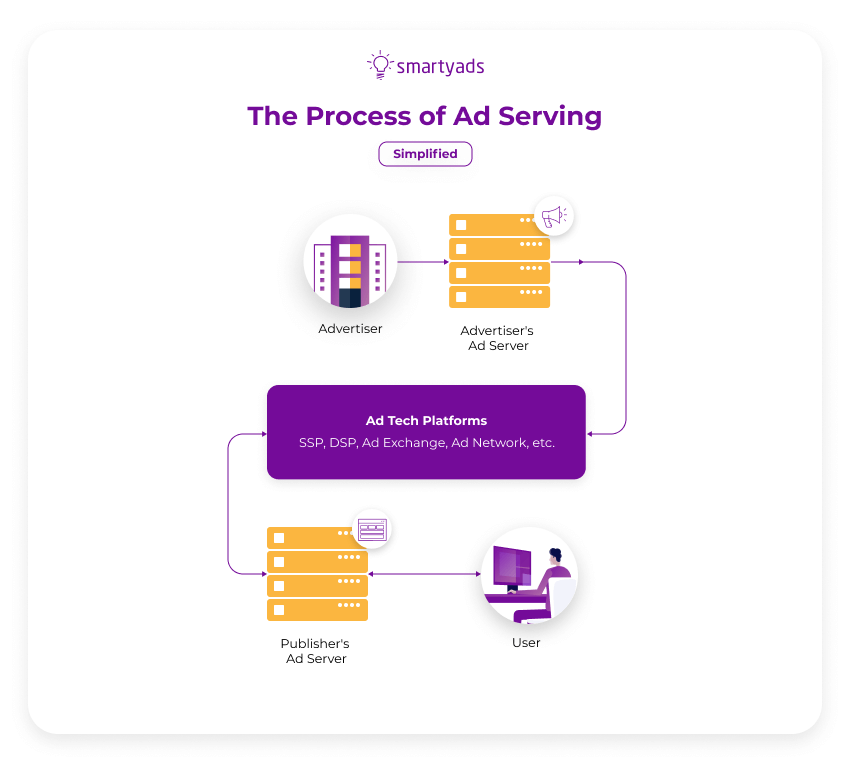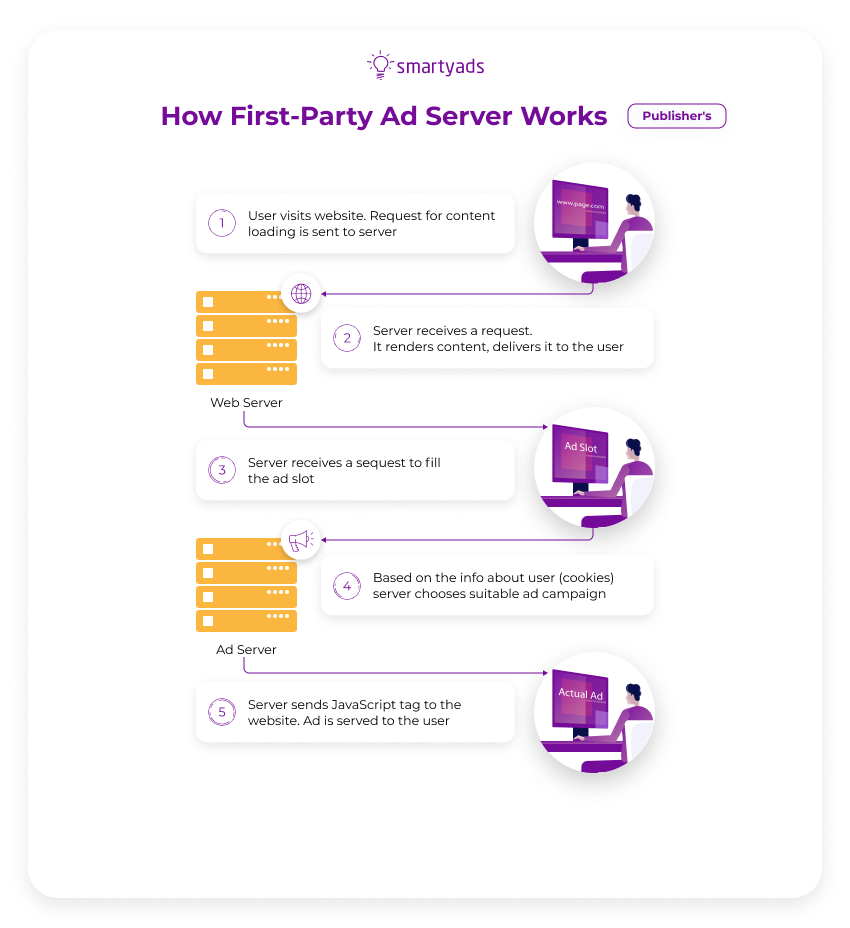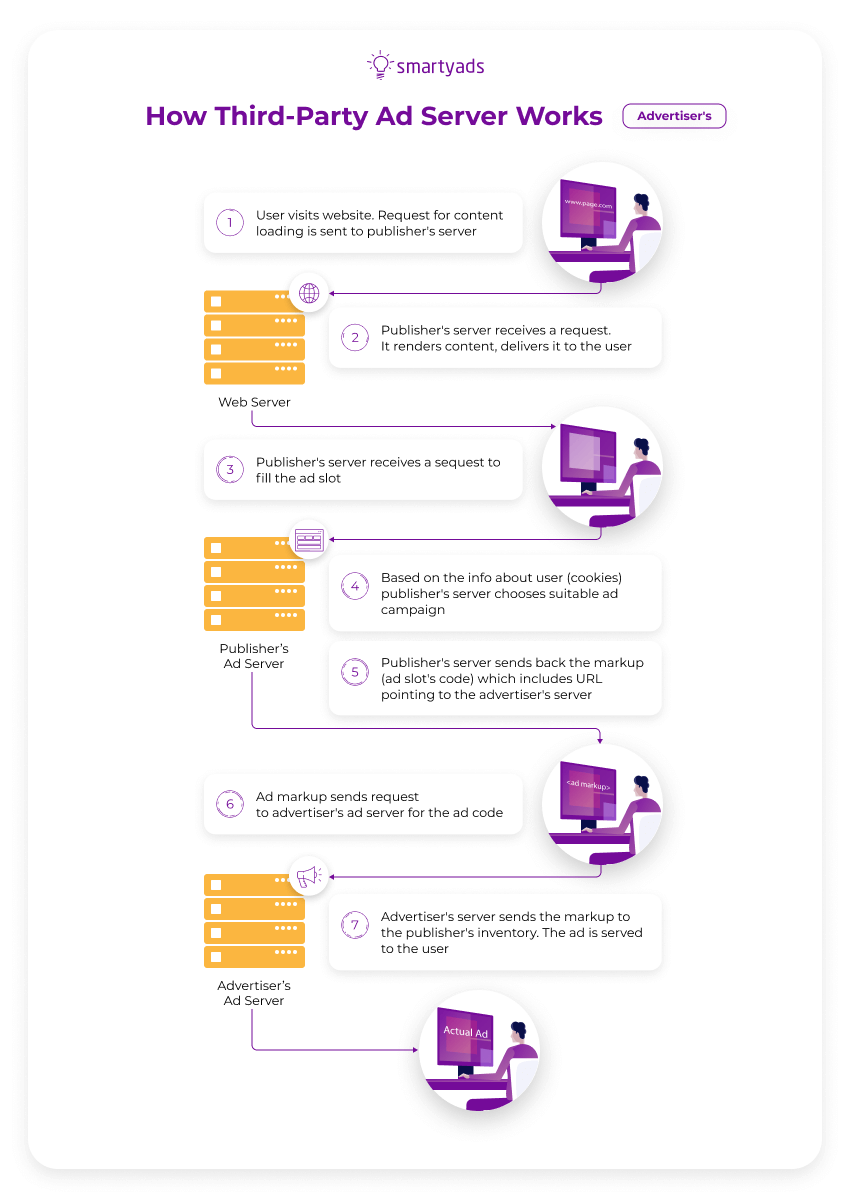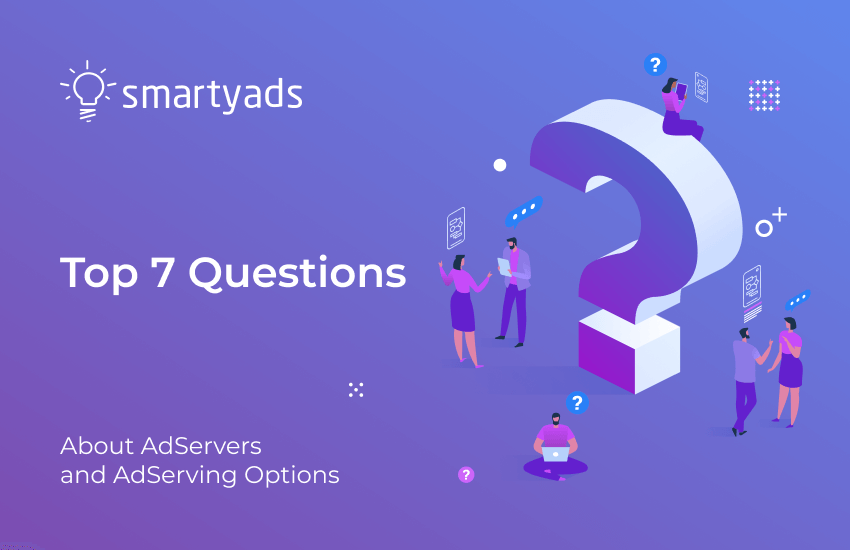When you talk about the programmatic ecosystem, you probably immediately think about demand side platforms (DSPs), supply side platforms (SSPs), and ad exchanges. Why? Because they are the key players in the online advertising ecosystem. These days ad servers are used by all popular ad tech systems and platforms including well-known ad exchanges and programmatically-powered ad networks.
However, there are smaller pieces of this massive adtech puzzle. Ad serving technology is the “grey cardinal” in the digital advertising landscape because it exerts power behind the scenes. But just because ad servers stay hidden from sight, it doesn’t mean advertisers and publishers should underestimate their work. Here are the top 7 FAQs about programmatic ad servers — answered.
What is an ad server?
Ad servers are technological systems (particularly web-based) responsible for hosting, optimizing, and distributing advertising content across various websites, social media platforms, and mobile apps. Ad servers are also sometimes referred to as “campaign management platforms”, “ad tracking systems”.
Ad servers are used in online marketing and programmatic advertising. You can think of an ad server as a large container for raw creative graphics: Every time a user visits a web page or app, a specific ad creative is fetched and served in the advertising slot. Ad-serving platforms are data-driven, they accumulate massive amounts of data arrays because they were primarily designed to store and serve. However, with rapid ad tech development, today’s ad server functionality can be far more sophisticated.
What is ad serving?
An ad serving platform is a technology cycle that uses software to place ads on various websites. It can be used either by demand side platform, supply side platform, ad exchange, or an ad network. An ad-serving engine is the core element of every ad server. It utilizes complex algorithms and advanced decision-making tools to select the most relevant ads for display.
The ad selection process is strictly restrained by the rules that are defined by advertisers and publishers and the ad server itself. These rules include such settings as targeting criteria, the frequency of ad viewing, ad priority, ad placement, digital ad format, earning potential, and more. Ad servers are also responsible for ad tracking, ad management, ad reporting, and ad billing.

Is there some classification for ad servers?
For publishers and advertisers. For starters, there are first party and the third party ads servers, in other words, these are the sell side and the buy side technologies. Ultimately, this is the same technology. However, since it serves different purposes advertisers and publishers apply it differently. Thus, first party servers help publishers to ensure control over their inventory, organization of ad placement, ad delivery optimization, and statistics delivery. Third party servers help advertisers to ensure that their creatives are rendered and optimized throughout all ad campaigns. As well, they are employed in overall campaign optimization and reporting.
Self and managed serve. Self serve servers are installed and maintained by their owners while the managed serve ones are run by third party tech vendors. Self serve servers have much broader functionalities since their scripts can be modified and customized anytime. However, they require substantial human resources, constant monitoring, and maintenance in order to support stable smooth functioning. Find a comparison table about it in the section “how to choose an ad server”.
Local and remote. An ad server can run locally, or remotely. If you have a local ad server that means you have direct physical access to it. Plus, you can also utilize the capacities of the third-party company that offers remote server access. Local servers are usually owned by publishers. Remote ad servers are managed ones, they operate independently and can serve multiple publishers. In this case, all ads are broadcasted from a single source, which allows advertisers to track ad placement across the Internet.
The story of the first ad server
The first ad server came to the scene in the distant 1995th when the primary purpose of it was to assist publishers with ad scheduling and ad slot filling. It was a company named FocaLink Media Services. The company's office was situated in Palo Alto, California. In 1998, the company changed its name to AdKnowledge, and later on, it was acquired by ModusLink Global Solutions. In 2004, the AdKnowledge brand was acquired by the Kansas City company, which now operates under this brand name.
There weren’t many opportunities to personalize the ads and the header information was the only way to organize targeted display or video ad serving. The browser could only pass information about the PC’s language, browser configuration, and type, OS installed on the computer and the webpage that this particular user loaded.
The first local ad server was released by NetGravity in January 1996 to serve ads from major Yahoo and Pathfinder publishers. In 1998, the company turned IPO, and a year later it was acquired by DoubleClick for publishers DFP. Then NetGravity ad server was renamed DART. In March 2008, DoubleClick was acquired by Google, which has been investing in the development of DART ever since. The latest version of their product is called Double Click Enterprise.
Since then ad server technology kept evolving in order to meet the growing requirements of the ad tech ecosystem - DSPs, SSPs, and ad networks that appeared later in the middle of the 2000th. Exactly during this period, a typical ad server gained such capacities as precise targeting, ad budget allocation, and the rest of the important features. Advertisers and publishers have also obtained the chance to run direct deals on programmatic platforms. This was a time when the first demand side platform and supply side platform equipped with ad server integration came to the scene.
Most popular ad servers in 2020
DoubleClick for publishers DFP is still considered to be the most popular option for publishers. According to the listings and ratings on SimilarTech, the following alternatives can be also regarded as strong options: OpenX, Atlas, SmartAd Server, and Adzerk. Some of these technologies are designed specifically for publishers while others also have options for advertisers.
How do third and first party ad servers work?
Ad-serving technology is a bit complex and involves many steps. Everything starts when a user visits a website or app. From there, an IP connection between the user’s computer and the publisher’s web server is established. The website begins to load. Meanwhile, ad tags on the site load, too, and call the sell-side ad server.
↓
When the publisher’s ad server receives the ad request, it immediately analyzes data about the user, such as geolocation, language, time of day, online behavior, and demographic attributes (age, gender, marital status, employment, etc.). Such data can be also transmitted from the data management platform.
↓
Then, the ad server sends requests to ad exchanges, where buyers bid on it if they are interested in the ad space and find the user-relevant.
↓
Ad servers also check how many times the potential ad was shown to this particular user in the past, called frequency capping. If the ad was shown too often, it is rejected.
↓
A publisher’s ad server processes millions of buyer requests and chooses the best paying ad in milliseconds. Then it redirects the browser to the marketer’s ad server and fetches the ad creative from the content delivery network (CDN).
↓
Finally, the ad is retrieved and successfully downloaded on the web page. This counts as an impression. Regardless of the number of calls, the user’s browser organizes the whole process of online advertising: ad selecting, and ad placing must not take longer than a second to guarantee high viewability.
↓
Thus, we’ve described in general terms how the advertising process is organized by the ad servers. However, if you want to plunge deep and sort every step of how it happens on the publisher and advertiser side, on the picture below you can see the difference between the work of the first party (publisher) ad servers and third party (advertiser) ad servers.
What is a publisher ad server?
Not all ad servers are created equal. There are two types of ad servers in the programmatic buying ecosystem: ad server for sellers (first party ad servers) and advertiser ad server (third party ad servers). These two platforms use similar technology but perform quite different functions.
Publisher ad servers (first party ad servers) help media sellers increase the value of every impression and maximize yield by serving the highest paying ads to viewers across their personal media domain. Ad servers are used by publishers to find optimal viewers for every impression, control how users engage with the ad (whether they click on it or not), check how many times the ad was displayed, and monitor overall performance.
Sell-side first party ad servers are also used by publishers to run creatives with different targeting and technical requirements across multiple formats. The ad-serving interface makes it easy for digital media sellers to add new buyers to their contact lists and stay organized by editing, managing, and deleting partners. Additionally, publishers can obtain independent reports about ad creatives, discover the best performing digital ad formats, and optimize their ad space on time.
Leveraging publisher ad servers (first party ad server) media-sellers can:
- Optimize and enhance the value of ad inventory and ad impressions.
- Control how users interact with all kinds of multi cross platform ad units: banner ads, mobile ads, video ads, rich media ads, etc.
- Provide additional information about ad inventory and generating ad revenue.
- Collect statistics regarding the number of impressions, clicks, measure the performance regarding suitable metric, and provide attribution (per month/week/day, etc).

What is an advertiser ad server?
Advertiser ad servers (or third party ad servers) help save advertisers time and money with the right tools. Their primary task is to store and manage the ad code. The marketer needs to download ad unit to the third party ad servers only once and can modify them anytime they wish with no need to send the updated copies to every trading partner. Instead, the latest version of the advertisers’ creative content helps advertisers to get access using the HTML link tag, which ultimately leads to the server. Top ad servers also provide advertisers with separate reports on the performance of their ads, ad revenue, and ad spending.
Third party ad server (buy side) is designed with media buyers’ logic. 3rd party ad servers help advertisers to achieve maximum profits for minimum costs and centralize the ad buying process across a variety of publishers. Ad servers also allow advertisers to track such metrics as impressions, clicks, conversions, and purchases. Ad server allows publishers to count what’s important. The core functionality of the buy-side ad server resembles that of the sell-side ad server, which is why so many small- and medium-sized brands use publisher ad servers, especially free ones.

Functions of the third party ad server boil down to:
- Storing and managing the ad code
- Configuring the tracking options for advertising campaigns
- Tracking the results of the ad campaigns (in the number of clicks, actions or impressions)
- Checking the reach of the ad campaign
- Matching the data with reports from publishers
- Optimization of the different ad campaigns
What are the features of an ad server?
Most of the ad servers offer a mixture of ad delivery and ad management features for advertisers and publishers (ad networks usually include those). Others have limited offers. When choosing an ad server, make sure it includes the following features:
- Ad creative upload: Supports all standard creative sizes and IAB (Interactive advertising bureau) formats, such as text, image, video, animation, audio, games, interactive, native, rich media, in-app, mobile, and others.
- Campaign scheduling: Determines the dates by which the campaign has to run.
- Automatic optimization: Chooses the best performing ads and serves more of those.
- Delivery speed: Determines how often impressions are delivered (evenly or as fast as possible). Location-based targeting: Targets by country, state, province, metro area, city, zip code, language.
- Technical targeting: Delivers ads to the web, mobile, tablet, or TV screens and offers various operating systems and cross-device targeting.
- Time targeting: Schedules ads to a specific time of the day when users are most active. Social and demographic targeting: Focuses on age, language, gender, nationality, income, employment status, etc.
- Behavioral targeting: Target consumers by their online behavior, search history, and interests.
- Retargeting: Analyzes consumer engagement with the brand in the past and displays the online ad to draw more attention and trigger more interaction such as clicking, subscribing, and purchasing.
- SEO: Allows bidding on keywords and ensures ads appear on search engine results pages.
- Creative sequencing: Allows setting a specific order for ads to appear, usually under the same creative concept.
- Frequency capping: Controls online ad serving - how many times the ad is shown to the same user and limits it to the number of impressions per hour, day, or a specified period.
- Ad tracking: Monitors whether the creative content is generating desired results and the proper traffic of ads happens and guarantees the advertising content is shown in front of intended demographics in the correct time and place.
- Reporting: Offers real-time, dashboard, notification alert, custom reports and provides granular reports on clicks, impressions, costs, ROI, and eCPI.
How do you choose an ad server?
For starters, you need to determine what tasks you need the ad server for. Essentially, the first and the third party servers are the same pieces of technology. However, they are used by publishers and advertisers differently because the demand and supply sides have different challenges and needs. As soon as you determine your core tasks it’s time to match them to specific functions of the platform. Assess every option from the standpoint of functionality they provide and whether those will be sufficient to satisfy your needs.
What’s also important, technically all servers can be categorized as self hosted and managed. Those two can work fine, but if the managed one is maintained by the tech provider, the maintenance and configuration of the self hosted (self serve) depends on you. In case your company has employees that have expertise and experience in dealing with such technologies, self serve one can be an option that saves a substantial part of your budget. Without knowledge, skills, and professionals in staff, it is recommended to opt for the managed one.
The comparison between self serve and managed ad server
Self serve servers Managed servers Upsides
- Scripts can be modified and adjusted according to the needs of a particular company. For this, the company needs front-end and back-end developers on staff.
- The script is usually very affordable or free of charge.
- With good tech professionals onboard you get more control over data protection and security.
- No need to have specialized knowledge. Managed servers usually have user-friendly and intuitive interfaces.
- No deployment needed.
- The updates and improvements are carried out by the tech vendor’s team.
- User support assists users and helps to sort out problems (if any).
- The performance of the server is constantly monitored.
Downsides
- Substantial human resources (needed to deploy the server and maintain it).
- Employees need to have sufficient experience and expertise with ad servers.
- Tech updates should be done regularly.
- The price is higher when compared to the self serve option.
- The script customization isn’t possible.
- The data is stored by the third party provider technology so you have less control over it.
Today, many tech vendors offer full-stack advertising solutions for publishers and advertisers. The advertising market has plenty of options - both self serve and managed serve. Such solutions are well-integrated and address all their online display advertising needs at once. No need to buy the best ad technology separately and go through the annoying integration across multiple providers. For example, SSPs and DSPs go along with integrated ad servers. Technology from the same vendor is guaranteed to run seamlessly and work together cohesively.
Free open source ad servers are also available as a part of inexpensive solutions. They are free to use. The open-source ad server supports basic functionality and is highly customizable. Examples of such ad servers include DFP Small Business, Orbit Open Ad Server, and Revive Adserver.
Mobile ad servers offer to target mobile-based criteria, such as device, software, mobile carrier, operating system, connection type, screen size, and more. Mobile advertising does not support cookies and requires more advanced tracking such as attributions using IDFA (Apple’s identifier for advertisers) or AAID (Google’s advertising ID). Mobile is the more speed-sensitive environment and places more workload on the cloud processing power. Mobile ad servers could be a part of a mobile real-time bidding framework for buyers and sellers: mobile DSPs/SSPs and mobile ad exchanges.
What is the cost of an ad server?
Ad server costs can vary depending on functionalities, provider,s and other characteristics. For Google Ad Manager users servers are free of charge (up to the certain threshold of served impressions), precisely, 90 million impressions for certain geos. After this, the customers get charged for impressions that come from non-AdSense networks.
The smarter an ad server is, the more expensive the installation and maintenance will be, as it takes more work and resources to keep it functioning. Many publishers interested in serving advertisements on their inventory can’t afford the essential level of server support required for serving ads. That’s why they choose to join an ad network or SSP. The same applies to advertisers who join networks or DSP. Such platforms may not provide the same level of customization and unique server configuration options as self-built ones. However, they provide demand and supply partners with all functionalities essential for organizing ad campaigns and serving ads.
Apart from this, such solutions usually offer a sufficient degree of control over ad operations: storage of creatives, optimizing ad campaigns, filtering, tracking, targeting, reporting, and the rest of the functions advertisers and publishers access on the platform. The interfaces of these programmatic tools are exceptionally user-friendly and suit people with no specific technical background.
To wrap it up
Advertising servers are essential components of the real-time bidding ecosystem and ad serving process in general. They bear major responsibility for storing and serving creative content onto various digital platforms, such as websites, social media outlets, and mobile apps. SSP, DSP, ad network, an ad exchange, and any other online advertising solution today needs ad server integration in order to serve ads and perform basic optimization functions. You can find lots of companies that currently offer self and managed serve, local, and remote server capabilities for both publishers and advertisers.
Selecting the one bear in mind your needs, purposes, and also what available companies have to offer. Independent server options will definitely enable greater levels of sophistication and customization, however, it is a good point to thoroughly consider if you need these functions and whether you have essential resources to maintain such technology on your own. Ad servers are deeply integrated into the ad tech ecosystem so everyone who wants to run ad campaigns or monetize their inventory effectively can access such capabilities using ad monetization solutions and programmatic media buying tools.
Choose your programmatic advertising platform to advertise and monetize effectively!
FAQ
An ad server is a type of server used to store and deliver online advertisements to websites, apps, and other types of ad inventory. Ad server hosts creatives and optimizes campaigns, organizes targeting, distributes ad content, and performs a set of important tasks for publishers and advertisers.
Such a process is complex and multilayered, it includes a selection of the creatives, matching the targeting criteria with data in cookies, analyzing campaign settings, organizing campaign tracking, reporting, management, and other operations.
Servers can be classified according to several criteria: purpose, maintenance, and location. Purpose: there are first party servers created for publishers and third party servers created for advertisers. Maintenance: self and managed serve servers. Location: local servers and remote servers.
First party server (publisher tech) receives a request to show content to the website visitor. It renders content while the ad slot request is being sent back to the server. The server analyzes the cookies of the visitor and matches the data with ad slot filling (campaign) requirements. Based on this information server chooses the ad campaign. The server sends a JavaScript tag to the website and the ad is getting served.
Third party server (advertiser tech) works like this: the publisher's server goes through the mentioned ad serving stages. Then the publisher's server sends back the markup (with a URL that points to the advertiser’s ad server). The markup is being sent to the advertiser’s server so the impression is counted. Then the advertiser’s server sends the markup to the publisher’s source and impression is served.
First party servers ensure optimization of ad inventory for publishers, control, and statistics delivery. The primary goal of third party servers is to help advertisers store creatives, organize targeting, tracking, optimization of the campaigns as well as reporting.
Support for various creatives, ad campaigns automation (scheduling, optimization, speedy delivery). Strong cross channel and cross device targeting, retargeting functionality). Creative allocation, frequency capping, tracking of the creatives with tags, etc., and performance reporting.




